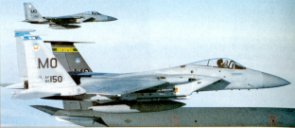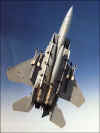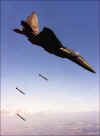 The McDonnell-Douglas F-15 Eagle was designed to be the primary air-superiority fighter for
the USAF. It is the first US operational aircraft whose engine thrust exceeds the weight
of the aircraft. This, combined with a low wing loading, makes the F-15 highly
manoeuvrable with excellent acceleration. The aircraft has an extremely impressive
performance. The first flight of the F-15 was on 27 July l972.
The McDonnell-Douglas F-15 Eagle was designed to be the primary air-superiority fighter for
the USAF. It is the first US operational aircraft whose engine thrust exceeds the weight
of the aircraft. This, combined with a low wing loading, makes the F-15 highly
manoeuvrable with excellent acceleration. The aircraft has an extremely impressive
performance. The first flight of the F-15 was on 27 July l972.
The USAF/McDonnell-Douglas F-15 development contract was a combination of cost-plus-incentives with successive target cost and demonstration milestones. The basic schedule was maintained, despite a few design changes. It is slightly larger and lighter than the F-4 Phantom, whose fighter role it was to replace, but the two Pratt & Whitney F100 turbofans each provided an extra 8,000 Ib thrust, nearly 50% additional power. The F-15 is equipped with an internally mounted 20 mm M61A-1 gun. In addition there are four AIM-7 Sparrow or AMRAAM medium range air-to-air missiles under the fuselage, plus four AIM-9 Sidewinder or ASRAAM short range air-to-air missiles. The first F-15A was delivered to the USAF in November 1974, followed by the two seat trainer F-15B a year later. In June 1979 new versions of the F-15 emerged, which had improved radar and larger internal fuel capacity, as well as the capability to fit conformal fuel tanks. The single seat fighter was designated F-15C and the two seat trainer was the F-15D.(more about the F-15) (see F-15E also)
TYPE
F-15AF-15B
F-15C
F-15D
F-15E
Number built/Converted
38461
482
93
215*
Remarks
365 to USAF59 to USAF
409 to USAF
61 to USAF
Thru FY96
NOTES:
- 19 F-15A to Israel
- 10 YF-15A's produced
- 2 F-15B to Israel
- 2 YF-15B's produced
- 1 YF-15B became YF-15E
- 18 F-15C to Israel
- 55 F-15C to Saudi Arabia
- 13 F-15D to Israel
- 19 F-15D to Saudi Arabia
- 20 F-15DJ built in Japan
- 25 F-15I (F-15E) to Israel
- 2 F-15J to Japan
- 72 F-15S to Saudi Arabia
SPECIFICATION
Wing: span 42 ft 9.75 in (13.05 m); aspect ratio 3.01; area
608.00 sq ft (56.48 mē)
Fuselage and tail: length 63 ft 9 in (19.43 m); height 18 ft
5.5 in (5.63 m); tailplane span 28 ft 3 in (8.61 m); wheel track 9 ft 0.25 in (2.75 m);
wheel base 17 ft 9.5 in (5.42 m)
Powerplant: two Pratt & Whitney F100-PW-220 turbofans each
rated at 14,670 lb st (65.26 kN) dry and 23,830 lb st (106.0 kN) with afterburning
Weights: operating empty 28,600 lb (12793 kg); normal take-off
44,630 lb (20244 kg) on an interception mission with four AIM-7 Sparrow AAMs; maximum
take-off 58,470 lb (26521 kg) with three 610-US gal (2309-litre) drop tanks or 68,000 lb
(30844 kg) with CFTs
Fuel and load: internal fuel 13,455 lb (6103 kg); external fuel
up to 9,750 lb (4423 kg) in two CFTs and 11,895 lb (5395 kg) in three 600-US gal
(2271-litre) drop tanks; maximum ordnance 16,000 or 23,600 lb (7257 or 10705 kg) without
or with CFTs respectively
Speed: maximum level speed 'clean' at 36,000 ft (10975 m) more
than 1,433 kt (1,650 mph; 2655 km/h); cruising speed at optimum altitude 495 kt (570 mph;
917 km/h)
Range: ferry range with drop tank more than 2,500 or 3,100 nm
(2,879 or 3,570 miles; 4633 or 5745 km) without or with CFTs respectively; combat radius
on an interception mission 1,061 nm (1,222 miles; 1967 km); endurance 5 hours 15 minutes
with CFTs or 15 hours with flight refueling
PERFORMANCE
maximum rate of climb at sea level more than 50,000 ft (15240 m) per minute;
service ceiling 60,000 ft (18290 m);
absolute ceiling 100,000 ft (30480 m);
take-off run 900 ft (274 m) at normal take-off weight;
landing run 3,500 ft (1067 m) at normal landing weight without brake parachute;
g-limits: -3 to +9










